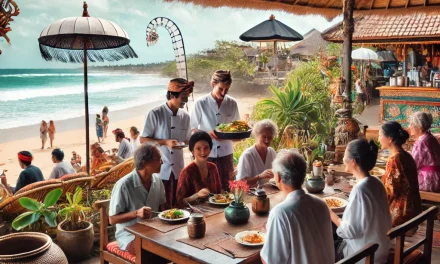When you think of Bali, images of serene beaches and lush rice paddies often come to mind. But there’s another shimmering gem that deserves your attention—the island’s incredible culinary scene. And what better way to immerse yourself in this vibrant culture than by attending Bali cooking classes featuring local ingredients? Trust me, it’s an experience that tickles the taste buds and nourishes the spirit.
A Flavorful Introduction to Balinese Cuisine
Before I dive into the details of my cooking class experience, let’s take a moment to appreciate the heart of Balinese cuisine: local ingredients. Tropical fruits, fresh vegetables, and aromatic herbs are key players in the culinary game here. I remember wandering through Ubud’s vibrant markets, entranced by the colors and scents. The sweet aroma of ripe mangoes and the pungent smell of lemongrass filled the air, making my stomach rumble with anticipation.
Balinese cooking is not just about flavor; it also embodies a rich culture and history. Many dishes are deeply rooted in tradition, showcasing techniques and ingredients handed down through generations. This is what makes the cooking classes so special—you’re not just learning how to cook; you’re stepping into a lifestyle.
The Big Decision: Choosing Your Cooking Class
With countless options to choose from, the first step in your culinary adventure is deciding on a cooking class. Do you want to cook in a traditional Balinese home or take classes at a professional cooking school? My personal recommendation is to go for a hands-on experience with a local chef who emphasizes using fresh, local ingredients.
One memorable class I attended was in a village just outside Ubud. The instructor, a charming Balinese woman named Ketut, warmly welcomed us into her home. As we sat down to enjoy a refreshing welcome drink made from fresh coconuts, she shared stories about her family and cooking traditions, making us feel like part of the family. This personal touch, combined with Ketut’s wealth of knowledge, made for an unforgettable experience.
Shopping for Ingredients: A Feast for the Senses
One of the highlights of my cooking class was the trip to the local market. If you think shopping at a grocery store is lively, you’ve never been to a Balinese market. Picture rows of colorful stalls brimming with vibrant fruits, vegetables, and spices. As we wandered through the bustling market, Ketut encouraged us to touch, smell, and taste everything.
I vividly recall biting into a juicy, sun-ripened mangosteen, its sweet and tangy flavor exploding in my mouth. Ketut also introduced us to “sambal,” a fiery chili paste made from freshly harvested chilis, lemongrass, and garlic. It was an eye-opening experience to understand how these ingredients come together in Balinese cooking and how they can be used to create complex flavors.
Cooking Class: Getting Hands-On
Once we had gathered all our ingredients, it was time to cook! In Ketut’s outdoor kitchen, equipped with a traditional stone stove, we dove right into the process. Under her guidance, we chopped, fried, and roasted our way to a mouthwatering meal.
The dish we prepared was called “Nasi Goreng,” a fragrant fried rice dish that’s a staple in Indonesian cuisine. It was not just about following a recipe; Ketut taught us the nuances. “The secret,” she said with a twinkle in her eye, “is in the use of good quality shallots and fresh vegetables.”
As we cooked, Ketut shared her family anecdotes, explaining how different dishes were served during ceremonies and celebrations. It made everything feel richer and more meaningful. I felt proud as I plated my Nasi Goreng, topped with a perfectly fried egg and a sprinkle of fresh herbs.
Enjoying the Fruits of Your Labor
After hours of cooking, the grand moment arrived: tasting our creations. Sitting at her beautifully set table, we dug into our colorful spread and savored every bite. The depth of flavor, enhanced by the fresh ingredients we had sourced from the market, was truly remarkable.
As we ate, the conversation flowed easily, enriched by the shared experience. We exchanged stories with fellow participants, connected through our love for food. It reminded me that cooking can bridge cultures, and food is a universal language that brings people together.
Practical Tips for Your Cooking Class Adventure
1. Do Your Research: Look for classes that emphasize local ingredients and authentic cooking techniques. Read reviews and perhaps ask your hotel for recommendations.
2. Dress Comfortably: Cooking can get messy! Wear clothes you don’t mind getting a little stained with spices or sauce.
3. Be Open-Minded: Each region in Bali has its flavors and specialties. Don’t be afraid to try new dishes and ingredients that you may not be familiar with.
4. Connect with Your Instructor: Ask questions! Most local chefs are excited to share their knowledge and stories. Building that rapport can enhance your cooking experience.
5. Have Fun! Cooking should be enjoyable, so don’t stress too much about perfection. Savor the experience and enjoy the food with your fellow classmates.
Conclusion: A Taste of Bali You Won’t Forget
Joining Bali cooking classes featuring local ingredients is more than just a culinary lesson; it’s an immersion into the Balinese way of life. From shopping at the market to cooking alongside a local chef, you peel back the layers of a culture that celebrates food as a form of love and connection.Whether you’re a budding chef or just looking to spice up your culinary skills, I promise that a cooking class in Bali will leave you with delicious recipes, cherished memories, and a deeper appreciation for this enchanting island. So grab your apron, embrace the vibrant flavors, and let Bali’s culinary tradition inspire your next meal!






